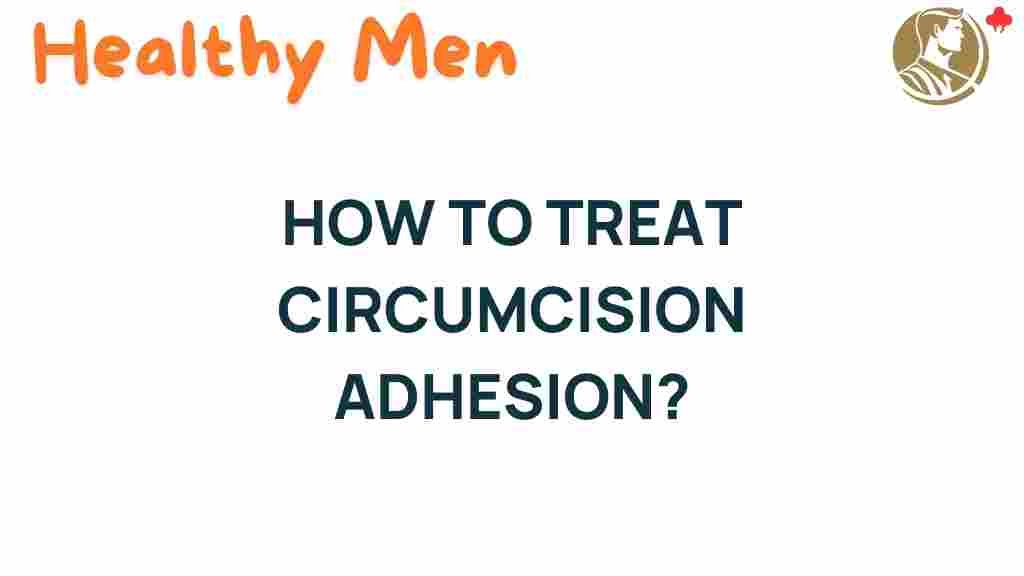Unraveling the Mystery: How to Treat Circumcision Adhesion
Circumcision adhesion is a condition that can occur when the skin of the penis adheres to the glans (the head of the penis) after circumcision. This issue can lead to discomfort, pain, and potential complications if not treated appropriately. In this article, we will explore the causes of circumcision adhesion, various treatment options available, the importance of seeking medical advice, pediatric care considerations, recovery tips, potential health complications, and surgical procedures that may be involved.
Understanding Circumcision Adhesion
Circumcision adhesion typically manifests as a band of tissue that forms between the glans and the remaining skin of the shaft. This condition can arise from inadequate healing after the circumcision procedure or improper aftercare. Understanding the condition is crucial for effective treatment and prevention of future complications.
Causes of Circumcision Adhesion
There are several factors that may contribute to the development of circumcision adhesion:
- Inadequate Aftercare: Not properly caring for the circumcision site can lead to adhesion.
- Infection: Post-operative infections can cause inflammation and scarring.
- Excessive Moisture: Allowing excessive moisture can hinder proper healing.
- Improper Technique: The method used during the circumcision may impact healing.
Treatment Options for Circumcision Adhesion
When it comes to treating circumcision adhesion, various options are available depending on the severity of the condition. Here are some common treatment methods:
1. Observation and Monitoring
In mild cases of circumcision adhesion, the pediatrician may recommend a period of observation. This involves monitoring the area for signs of improvement or worsening. During this time, parents should ensure proper hygiene and follow any care instructions given by the healthcare provider.
2. Medical Treatments
If monitoring indicates that the adhesion persists or worsens, medical treatments may be necessary:
- Topical Steroids: Prescription creams may help reduce inflammation and allow the skin to separate.
- Antibiotics: If an infection is present, antibiotics may be prescribed to clear the infection before further treatment.
3. Surgical Interventions
In more severe cases, surgical procedures may be required to correct the adhesion. This could include:
- Lysis of Adhesions: A minor surgical procedure to detach the adhered skin.
- Re-circumcision: In some cases, a complete re-circumcision may be necessary to correct the issue.
4. Home Remedies and Care
In addition to medical treatments, parents may consider some home care options:
- Warm Baths: Soaking in warm water can help soothe the area and promote healing.
- Gentle Massage: If advised by a healthcare provider, gentle massage may help break down adhesion.
Importance of Medical Advice
It is crucial to seek medical advice when dealing with circumcision adhesion. Pediatricians and urologists are well-equipped to diagnose the condition and recommend appropriate treatment options. Self-diagnosing or treating without professional guidance can lead to complications or worsening of the condition.
When to Seek Help
Parents should contact a healthcare provider if they notice:
- Persistent pain or discomfort in the child.
- Signs of infection, such as redness, swelling, or discharge.
- Difficulty urinating or bleeding.
Pediatric Care Considerations
Pediatric care plays an essential role in managing circumcision adhesion. Parents should ensure that their child receives regular check-ups to monitor healing and address any complications early. Pediatricians can provide tailored advice on:
- Proper hygiene practices.
- Signs of complications to watch for.
- When to seek further medical intervention.
Recovery Tips for Circumcision Adhesion
Recovery from circumcision adhesion can be straightforward with proper care. Here are some tips to promote healing:
- Maintain Hygiene: Keep the area clean and dry.
- Avoid Irritation: Use loose-fitting clothing to prevent friction.
- Follow Medical Instructions: Adhere to any care instructions from your healthcare provider.
Nutrition and Hydration
Good nutrition and hydration can support overall healing. Ensure the child has a balanced diet rich in vitamins and minerals, which can aid recovery.
Health Complications Associated with Circumcision Adhesion
While many cases of circumcision adhesion can be treated effectively, there are potential health complications that can arise if left unaddressed:
- Infection: Adhesions can create pockets where bacteria may thrive, leading to infection.
- Scarring: Persistent adhesion can lead to scarring that may require surgical intervention.
- Urinary Issues: In severe cases, adhesions can affect urination and lead to further complications.
Surgical Procedures for Circumcision Adhesion
For cases where conservative treatments fail, surgical procedures may be necessary. These procedures can range from simple lysis of adhesions to more complex surgeries like re-circumcision. It is crucial to discuss the risks and benefits of any surgical intervention with a qualified healthcare provider.
Post-Surgery Care
If surgery is performed, follow-up care is vital for a successful recovery:
- Schedule follow-up appointments to monitor healing.
- Follow any prescribed medications to manage pain or prevent infection.
- Adhere to post-operative care instructions provided by the surgeon.
Conclusion
Circumcision adhesion can be a concerning condition, but with proper understanding and treatment options, it can be effectively managed. Seeking timely medical advice, especially from pediatric care specialists, is essential in addressing this issue. Whether through monitoring, medical treatments, or surgical procedures, parents can take proactive steps to ensure their child’s health and well-being. For more information on pediatric care and related topics, consider visiting this resource.
If you suspect your child may be experiencing circumcision adhesion or any related issues, do not hesitate to reach out to a healthcare professional for guidance and support.
For further reading on surgical procedures related to circumcision, you can check out this external link.
This article is in the category Conditions and created by healthymen Team
